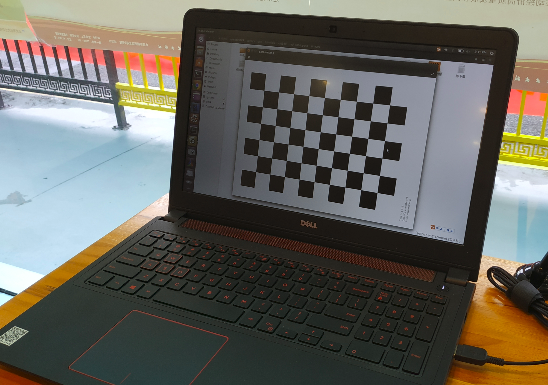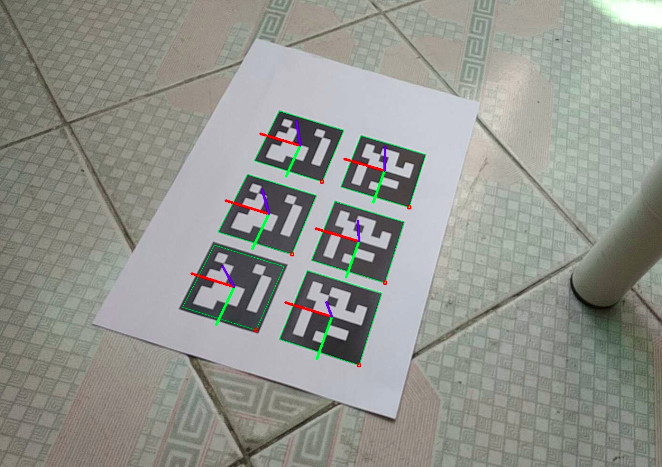简单的玩了下opencv里头的aruco,用的手机相机,手机装了个 ip摄像头,这样视频就可以传到电脑上了。

首先是标定,我没打印chessboard,直接在电脑屏幕上显示,拍了17张,大概如下:

又在手机上装了个 尺子 之类的app,比划着量了下,每个格子大概是18.1 mm,这个棋盘是10 x 7的棋盘。
要pip install opencv-contrib-python才有扩展模块,扩展模块中包含aruco
然后标定了一下:


1 import cv2
2 import numpy as np
3 import glob
4 import matplotlib.pyplot as plt
5 import matplotlib.patches as patches
6
7
8 # 找棋盘格角点
9
10 criteria = (cv2.TERM_CRITERIA_EPS + cv2.TERM_CRITERIA_MAX_ITER, 30, 0.001) # 阈值
11 #棋盘格模板规格
12 w = 9 # 10 - 1
13 h = 6 # 7 - 1
14 # 世界坐标系中的棋盘格点,例如(0,0,0), (1,0,0), (2,0,0) ....,(8,5,0),去掉Z坐标,记为二维矩阵
15 objp = np.zeros((w*h,3), np.float32)
16 objp[:,:2] = np.mgrid[0:w,0:h].T.reshape(-1,2)
17 objp = objp*18.1 # 18.1 mm
18
19 # 储存棋盘格角点的世界坐标和图像坐标对
20 objpoints = [] # 在世界坐标系中的三维点
21 imgpoints = [] # 在图像平面的二维点
22
23 images = glob.glob('./chessboard/*.jpg') # 拍摄的十几张棋盘图片所在目录
24
25 i = 1
26 for fname in images:
27
28 img = cv2.imread(fname)
29 gray = cv2.cvtColor(img,cv2.COLOR_BGR2GRAY)
30 # 找到棋盘格角点
31 ret, corners = cv2.findChessboardCorners(gray, (w,h),None)
32 # 如果找到足够点对,将其存储起来
33 if ret == True:
34 print("i:", i)
35 i = i+1
36
37 cv2.cornerSubPix(gray,corners,(11,11),(-1,-1),criteria)
38 objpoints.append(objp)
39 imgpoints.append(corners)
40 # 将角点在图像上显示
41 cv2.drawChessboardCorners(img, (w,h), corners, ret)
42 cv2.namedWindow('findCorners', cv2.WINDOW_NORMAL)
43 cv2.resizeWindow('findCorners', 810, 405)
44 cv2.imshow('findCorners',img)
45 cv2.waitKey(1)
46 cv2.destroyAllWindows()
47 #%% 标定
48 ret, mtx, dist, rvecs, tvecs = \
49 cv2.calibrateCamera(objpoints, imgpoints, gray.shape[::-1], None, None)
50
51
52 print("ret:",ret )
53 print("mtx:\n",mtx) # 内参数矩阵
54 print("dist:\n",dist ) # 畸变系数 distortion cofficients = (k_1,k_2,p_1,p_2,k_3)
55 print("rvecs:\n",rvecs) # 旋转向量 # 外参数
56 print("tvecs:\n",tvecs ) # 平移向量 # 外参数标定结果里对aruco有用的是 mtx 和 dist。
然后打印包含aruco的marker的纸,运行下面的代码就可以玩了:


1 import numpy as np
2 import time
3 import cv2
4 import cv2.aruco as aruco
5
6 #with np.load('webcam_calibration_output.npz') as X:
7 # mtx, dist, _, _ = [X[i] for i in ('mtx','dist','rvecs','tvecs')]
8
9 #mtx =
10 #2946.48 0 1980.53
11 #0 2945.41 1129.25
12 #0 0 1
13
14 mtx = np.array([
15 [2946.48, 0, 1980.53],
16 [ 0, 2945.41, 1129.25],
17 [ 0, 0, 1],
18 ])
19 #我的手机拍棋盘的时候图片大小是 4000 x 2250
20 #ip摄像头拍视频的时候设置的是 1920 x 1080,长宽比是一样的,
21 #ip摄像头设置分辨率的时候注意一下
22
23
24 dist = np.array( [0.226317, -1.21478, 0.00170689, -0.000334551, 1.9892] )
25
26 video = "http://admin:admin@192.168.1.2:8081/" # 手机ip摄像头
27 # 根据ip摄像头在你手机上生成的ip地址更改,右上角可修改图像分辨率
28
29 cap = cv2.VideoCapture(video)
30
31
32 font = cv2.FONT_HERSHEY_SIMPLEX #font for displaying text (below)
33
34 #num = 0
35 while True:
36 ret, frame = cap.read()
37 # operations on the frame come here
38
39 gray = cv2.cvtColor(frame, cv2.COLOR_BGR2GRAY)
40 aruco_dict = aruco.Dictionary_get(aruco.DICT_6X6_250)
41 parameters = aruco.DetectorParameters_create()
42
43 '''
44 detectMarkers(...)
45 detectMarkers(image, dictionary[, corners[, ids[, parameters[, rejectedI
46 mgPoints]]]]) -> corners, ids, rejectedImgPoints
47 '''
48
49 #lists of ids and the corners beloning to each id
50 corners, ids, rejectedImgPoints = aruco.detectMarkers(gray,
51 aruco_dict,
52 parameters=parameters)
53
54 # if ids != None:
55 if ids is not None:
56
57 rvec, tvec, _ = aruco.estimatePoseSingleMarkers(corners, 0.05, mtx, dist)
58 # Estimate pose of each marker and return the values rvet and tvec---different
59 # from camera coeficcients
60 (rvec-tvec).any() # get rid of that nasty numpy value array error
61
62 # aruco.drawAxis(frame, mtx, dist, rvec, tvec, 0.1) #Draw Axis
63 # aruco.drawDetectedMarkers(frame, corners) #Draw A square around the markers
64
65 for i in range(rvec.shape[0]):
66 aruco.drawAxis(frame, mtx, dist, rvec[i, :, :], tvec[i, :, :], 0.03)
67 aruco.drawDetectedMarkers(frame, corners)
68 ###### DRAW ID #####
69 # cv2.putText(frame, "Id: " + str(ids), (0,64), font, 1, (0,255,0),2,cv2.LINE_AA)
70
71
72 else:
73 ##### DRAW "NO IDS" #####
74 cv2.putText(frame, "No Ids", (0,64), font, 1, (0,255,0),2,cv2.LINE_AA)
75
76 # Display the resulting frame
77 cv2.imshow("frame",frame)
78
79 key = cv2.waitKey(1)
80
81 if key == 27: # 按esc键退出
82 print('esc break...')
83 cap.release()
84 cv2.destroyAllWindows()
85 break
86
87 if key == ord(' '): # 按空格键保存
88 # num = num + 1
89 # filename = "frames_%s.jpg" % num # 保存一张图像
90 filename = str(time.time())[:10] + ".jpg"
91 cv2.imwrite(filename, frame)最后效果如下:

来源:oschina
链接:https://my.oschina.net/u/4285472/blog/4401327